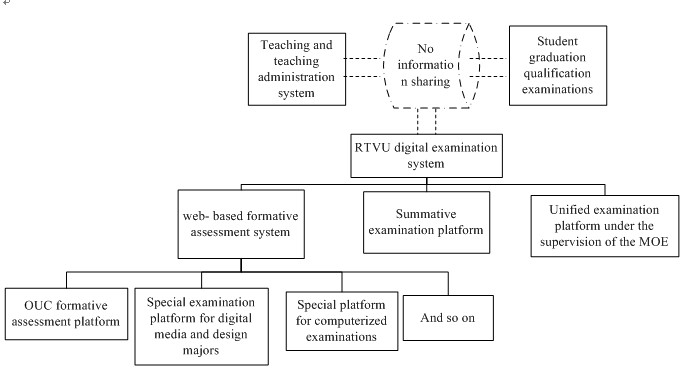Page 2 of 5
The research for this paper has collected examination administration documents, course examination papers, examination analysis reports, and teaching supervision reports from relevant OUC courses. Of the 50 curriculum evaluation management documents, 27 are about regulation systems. On average, each term there are 856 courses that require examinations and there are four sets of examination papers for each subject in storage. There are a total of 3424 sets of papers in storage. There are 18 national examination inspection reports. There are approximately 309 examination analysis reports for different branch schools of the RTVUs per semester. There are approximately 26 formative exercise books, which represent the basic element of teaching supervision for each semester. A large amount of data shows that many national unified courses of the OUC adopt the traditional campus education course examination model. The basic characteristics can be seen in Figure 2. National unified examinations include formative assessments and summative examinations. Generally speaking, formative assessments make up 20% of the total marks, while summative examinations make up the remaining 80%. If the proportion of formative assessments exceeds 30%, then “double pass regulations” have to be implemented i.e. one can only obtain course credits when one passes both the formative assessments and summative examinations. In recent years, following the development of web-based examination pilot schemes, some courses have increased the proportion of formative assessments. 10 courses have based 100% of total marks on formative assessments, including Computerized Accounting, Delphi program design, the Design and Practice of Online Courses, Online Learning Tools and Applications, and Auditing. The national unified examinations are designed, printed, issued, organized, held and reviewed by the OUC. Examination papers will be centrally reviewed by local universities in accordance with the OUC’s requirements. In addition, interviews with relevant examination personnel have identified issues such as unsuitable examination arrangements, lack of people-first layout, and insufficient analysis of examination data.

Figure 2 National unified written examinations
As mentioned above, following its strategic transformation, the OUC has increasingly emphasized the integration of modern information technology. As a result, the original examination model, unified examinations, and the proportion of formative assessments and summative examinations no longer meet the needs of the OUC. A number of areas of unsuitability have appeared, including the high costs produced by written examinations.
2. Evidence analysis and issue construction
The collected research materials were reviewed to find out the most frequently occurring events and cases. Having sorted out and coded the relevant documents such as the examination documents, examination records, examination files, analysis reports, examination papers and interview records, we have identified the following key problems with the OUC digital examination system.
2,1 Isolated information: With the promotion of the “Web-based curricular examination pilot project”, it is necessary to design examinations based on the nature and characteristics of the course. As a result, a number of different examination systems for each course have emerged. From a database perspective, the current state of the OUC’s digital examinations is shown in Figure 3. We can see that a multi-database layout has appeared both outside of and within the OUC examination system. The database information for each examination system is relatively isolated from educational administration. Student information cannot be shared between the three platforms, creating repetition and wasted resources. The lack of integration of examination results into administrative systems, makes it difficult to fully use and explore digital examination information.

Figure 3 The internal and external structure of the OUC digital examination system